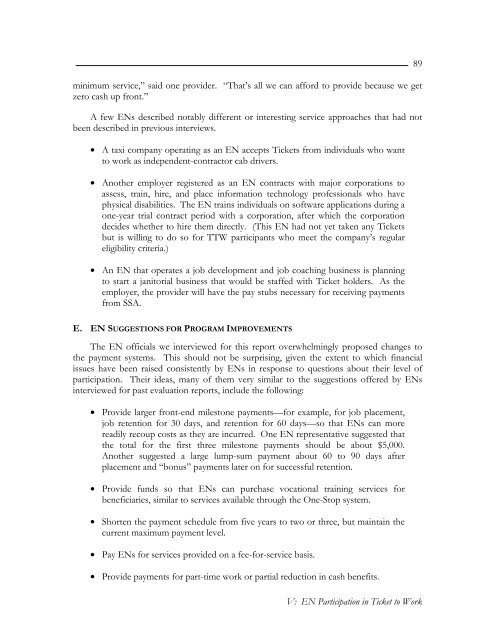Evaluation of the Ticket to Work Program, Implementation ...
Evaluation of the Ticket to Work Program, Implementation ...
Evaluation of the Ticket to Work Program, Implementation ...
You also want an ePaper? Increase the reach of your titles
YUMPU automatically turns print PDFs into web optimized ePapers that Google loves.
minimum service,” said one provider. “That’s all we can afford <strong>to</strong> provide because we getzero cash up front.”A few ENs described notably different or interesting service approaches that had notbeen described in previous interviews.• A taxi company operating as an EN accepts <strong>Ticket</strong>s from individuals who want<strong>to</strong> work as independent-contrac<strong>to</strong>r cab drivers.• Ano<strong>the</strong>r employer registered as an EN contracts with major corporations <strong>to</strong>assess, train, hire, and place information technology pr<strong>of</strong>essionals who havephysical disabilities. The EN trains individuals on s<strong>of</strong>tware applications during aone-year trial contract period with a corporation, after which <strong>the</strong> corporationdecides whe<strong>the</strong>r <strong>to</strong> hire <strong>the</strong>m directly. (This EN had not yet taken any <strong>Ticket</strong>sbut is willing <strong>to</strong> do so for TTW participants who meet <strong>the</strong> company’s regulareligibility criteria.)• An EN that operates a job development and job coaching business is planning<strong>to</strong> start a jani<strong>to</strong>rial business that would be staffed with <strong>Ticket</strong> holders. As <strong>the</strong>employer, <strong>the</strong> provider will have <strong>the</strong> pay stubs necessary for receiving paymentsfrom SSA.89E. EN SUGGESTIONS FOR PROGRAM IMPROVEMENTSThe EN <strong>of</strong>ficials we interviewed for this report overwhelmingly proposed changes <strong>to</strong><strong>the</strong> payment systems. This should not be surprising, given <strong>the</strong> extent <strong>to</strong> which financialissues have been raised consistently by ENs in response <strong>to</strong> questions about <strong>the</strong>ir level <strong>of</strong>participation. Their ideas, many <strong>of</strong> <strong>the</strong>m very similar <strong>to</strong> <strong>the</strong> suggestions <strong>of</strong>fered by ENsinterviewed for past evaluation reports, include <strong>the</strong> following:• Provide larger front-end miles<strong>to</strong>ne payments—for example, for job placement,job retention for 30 days, and retention for 60 days—so that ENs can morereadily recoup costs as <strong>the</strong>y are incurred. One EN representative suggested that<strong>the</strong> <strong>to</strong>tal for <strong>the</strong> first three miles<strong>to</strong>ne payments should be about $5,000.Ano<strong>the</strong>r suggested a large lump-sum payment about 60 <strong>to</strong> 90 days afterplacement and “bonus” payments later on for successful retention.• Provide funds so that ENs can purchase vocational training services forbeneficiaries, similar <strong>to</strong> services available through <strong>the</strong> One-S<strong>to</strong>p system.• Shorten <strong>the</strong> payment schedule from five years <strong>to</strong> two or three, but maintain <strong>the</strong>current maximum payment level.• Pay ENs for services provided on a fee-for-service basis.• Provide payments for part-time work or partial reduction in cash benefits.V: EN Participation in <strong>Ticket</strong> <strong>to</strong> <strong>Work</strong>
















